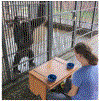Flexible information-seeking in chimpanzees
- PMID: 39059117
- PMCID: PMC11343684
- DOI: 10.1016/j.cognition.2024.105898
Flexible information-seeking in chimpanzees
Abstract
Humans can flexibly use metacognition to monitor their own knowledge and strategically acquire new information when needed. While humans can deploy these skills across a variety of contexts, most evidence for metacognition in animals has focused on simple situations, such as seeking out information about the location of food. Here, we examine the flexibility, breadth, and limits of this skill in chimpanzees. We tested semi-free-ranging chimpanzees on a novel task where they could seek information by standing up to peer into different containers. In Study 1, we tested n = 47 chimpanzees to assess if chimpanzees would spontaneously engage in information-seeking without prior experience, as well as to characterize individual variation in this propensity. We found that many chimpanzees engaged in information-seeking with minimal experience, and that younger chimpanzees and females were more likely to do so. In two subsequent studies, we then further tested chimpanzees who initially showed robust information-seeking on new variations of this task, to disentangle the cognitive processing shaping their behaviors. In Study 2, we examined how a subset of n = 12 chimpanzees applied these skills to seek information about the location versus the identity of rewards, and found that chimpanzees were equally adept at seeking out location and identity information. In Study 3, we examined whether a subset of n = 6 chimpanzees could apply these skills to make more efficacious decisions when faced with uncertainty about reward payoffs. Chimpanzees were able to use information-seeking to resolve risk and choose more optimally when faced with uncertain payoffs, although they often also engaged in information-seeking when it was not strictly necessary. These results identify core features of flexible metacognition that chimpanzees share with humans, as well as constraints that may represent key evolutionary shifts in human cognition.
Keywords: Comparative cognition; Comparative development; Decision-making; Metacognition.
Copyright © 2024 Elsevier B.V. All rights reserved.
Figures





References
-
- Bates D (2010). The LME4 package: linear mixed-effects models using S4 classes. See http://www.R-project.org.
MeSH terms
Grants and funding
LinkOut - more resources
Full Text Sources

